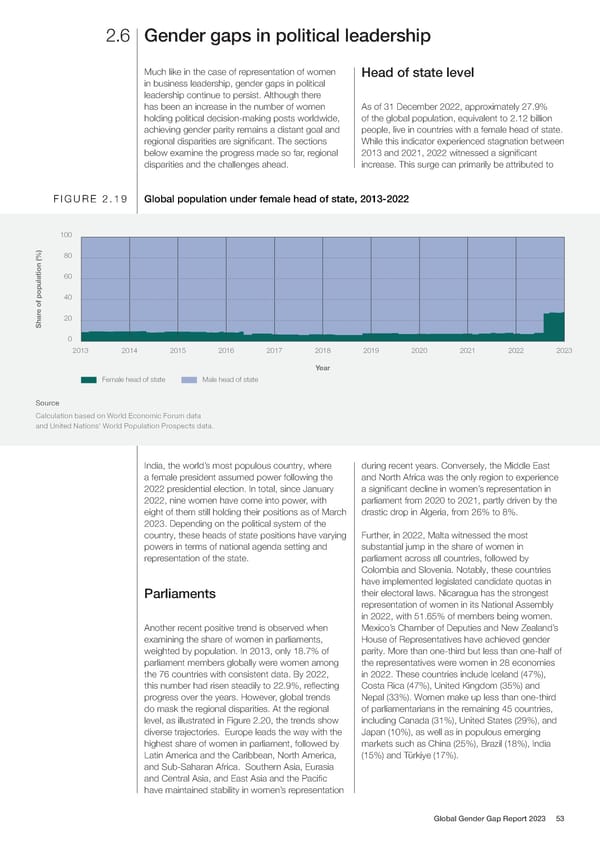2.6 Gender gaps in political leadership Much like in the case of representation of women Head of state level in business leadership, gender gaps in political leadership continue to persist. Although there has been an increase in the number of women As of 31 December 2022, approximately 27.9% holding political decision-making posts worldwide, of the global population, equivalent to 2.12 billion achieving gender parity remains a distant goal and people, live in countries with a female head of state. regional disparities are signi昀椀cant. The sections While this indicator experienced stagnation between below examine the progress made so far, regional 2013 and 2021, 2022 witnessed a signi昀椀cant disparities and the challenges ahead. increase. This surge can primarily be attributed to FIGURE 2.19 Global population under female head of state, 2013-2022 100 80 60 40 e of population (%) 20 Shar 0 2013 2014 2015 2016 2017 2018 2019 2020 2021 2022 2023 Year Female head of state Male head of state Source Calculation based on World Economic Forum data and United Nations' World Population Prospects data. India, the world’s most populous country, where during recent years. Conversely, the Middle East a female president assumed power following the and North Africa was the only region to experience 2022 presidential election. In total, since January a signi昀椀cant decline in women’s representation in 2022, nine women have come into power, with parliament from 2020 to 2021, partly driven by the eight of them still holding their positions as of March drastic drop in Algeria, from 26% to 8%. 2023. Depending on the political system of the country, these heads of state positions have varying Further, in 2022, Malta witnessed the most powers in terms of national agenda setting and substantial jump in the share of women in representation of the state. parliament across all countries, followed by Colombia and Slovenia. Notably, these countries have implemented legislated candidate quotas in Parliaments their electoral laws. Nicaragua has the strongest representation of women in its National Assembly in 2022, with 51.65% of members being women. Another recent positive trend is observed when Mexico’s Chamber of Deputies and New Zealand’s examining the share of women in parliaments, House of Representatives have achieved gender weighted by population. In 2013, only 18.7% of parity. More than one-third but less than one-half of parliament members globally were women among the representatives were women in 28 economies the 76 countries with consistent data. By 2022, in 2022. These countries include Iceland (47%), this number had risen steadily to 22.9%, re昀氀ecting Costa Rica (47%), United Kingdom (35%) and progress over the years. However, global trends Nepal (33%). Women make up less than one-third do mask the regional disparities. At the regional of parliamentarians in the remaining 45 countries, level, as illustrated in Figure 2.20, the trends show including Canada (31%), United States (29%), and diverse trajectories. Europe leads the way with the Japan (10%), as well as in populous emerging highest share of women in parliament, followed by markets such as China (25%), Brazil (18%), India Latin America and the Caribbean, North America, (15%) and Türkiye (17%). and Sub-Saharan Africa. Southern Asia, Eurasia and Central Asia, and East Asia and the Paci昀椀c have maintained stability in women’s representation Global Gender Gap Report 2023 53
 Global Gender Gap Report 2023 Page 52 Page 54
Global Gender Gap Report 2023 Page 52 Page 54